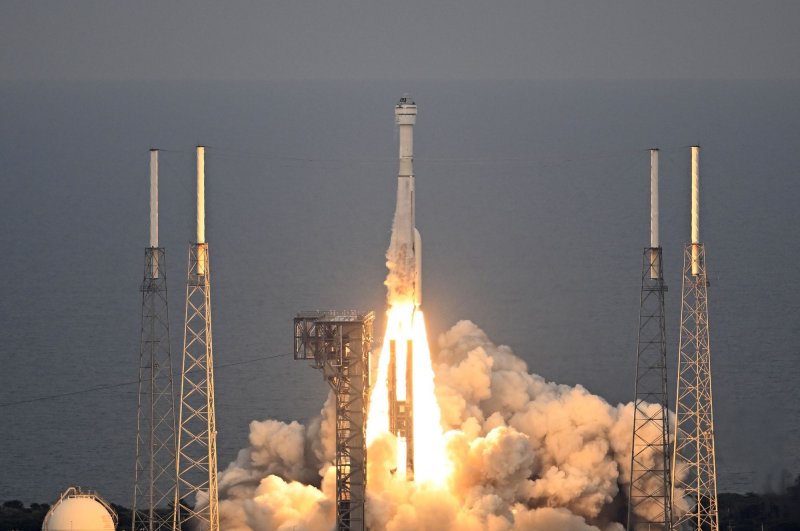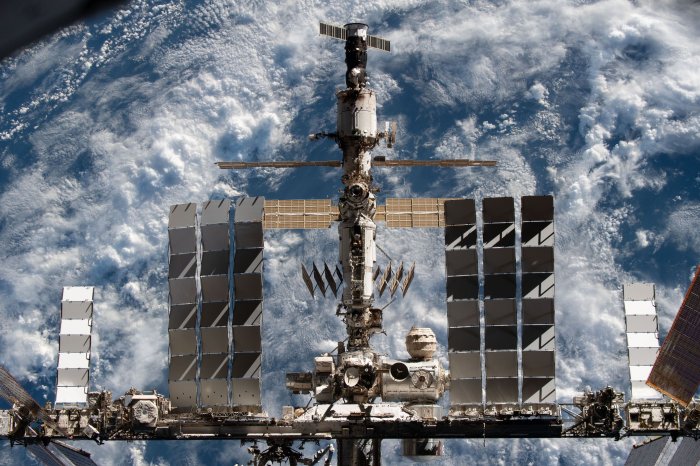1 of 8 | United Launch Alliance successfully launched its Atlas V rocket to boost the Boeing Starliner spacecraft for NASA from Complex 41 at the Cape Canaveral Space Force Station Thursday. Photo by Joe Marino/UPI |
License Photo
ORLANDO, Fla., May 19 (UPI) -- Boeing and NASA successfully launched the company's Starliner spacecraft to the International Space Station on Thursday.
A United Launch Alliance Atlas V rocket lifted off from Space Launch Complex 41 at Cape Canaveral Space Force Station in Florida at 6:55 p.m. EDT for Operation Flight Test-2.
At 7:31 Starliner completed its orbital insertion burn, placing it on a path to dock with the International Space Station.
Following Thursday's launch, Starliner is set to arrive at the ISS around 7:10 p.m. EDT on Friday.
The long-delayed test aims for Starliner to conduct an uncrewed flight to the orbital outpost that would pave the way for a crewed test mission later this year.
The flight is a repeat of a test flight in 2019 that was cut short after Boeing and NASA detected anomalies with the spacecraft and its software, which cost Boeing $600 million.
Developed as part of a public-private partnership, the Starliner spacecraft will give NASA a second spacecraft to ferry astronauts to and from the space station.
The other is SpaceX's Crew Dragon, which has successfully launched seven crews of astronauts -- five for NASA, two for private companies -- since its inaugural flight in 2020.
Steve Stitch, NASA's commercial crew program manager, said Starliner is ready for Thursday's test.
"We met with the teams at Boeing and ULA and there were very few issues to address before launch," Stitch told UPI in an interview. "It was a very clean review and we are ready to fly."
Months spent correcting issues
Ahead of OFT-2, engineers at Boeing spent several months investigating a valve issue that cropped up last summer. Since then, engineers have swapped out Starliner's service module, including a new propulsion system and new set of valves.
To mitigate the moisture intrusion issues that plagued the craft last summer, ultimately leading to valves that were corroded shut, Boeing says it improved valve seals and added nitrogen purges that will keep atmospheric humidity out of the propulsion system.
"We didn't find any other issues with the spacecraft, other than the valves," Michelle Parker, vice president and deputy general manager for Boeing Space and Launch, told UPI in an interview.
"We're going to cycle the valves every few days to help with potential corrosion and to reduce moisture," Parker said.
The Boeing team said safety is its utmost concern.
"It's incredibly difficult to design and build this type of spacecraft," Mark Nappi, Boeing's Starliner program manager, said. "We're committed to make the program the safest and best quality possible."
Uncrewed delivery of supplies
There won't be any astronauts on board this flight. Boeing will fly a test dummy named Rosie, to honor "Rosie the Riveter."
She will be outfitted with an array of sensors to provide the company with flight data from inside the spacecraft.
Also on board will be more than 500 pounds of food and supplies for astronauts currently onboard the ISS. Stitch said that once it completes its mission, the craft will return to Earth with more than 600 pounds of cargo.
Forecasters predict a 70% chance of favorable weather conditions at liftoff on Thursday. Their main concerns are the potential for thunderstorm development and lightning that could be triggered by the rocket as it makes its way to orbit.
There is a backup opportunity on Friday, but that window has only a 40% chance of good weather.
The craft is scheduled to remain in orbit at ISS for six days, at which point it will undock itself and return to Earth, landing under parachute at White Sands Space Harbor in New Mexico.
The International Space Station is pictured from the SpaceX Crew Dragon Endeavour during a flyaround of the orbiting lab that took place following its undocking from the Harmony module’s space-facing port on November 8. Photo courtesy of NASA
















